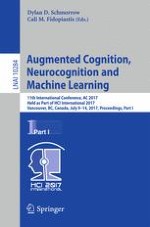This volume constitutes the proceedings of the 11th International Conference on Augmented Cognition, AC 2017, held as part of the International Conference on Human-Computer Interaction, HCII 2017, which took place in Vancouver, BC, Canada, in July 2017. HCII 2017 received a total of 4340 submissions, of which 1228 papers were accepted for publication after a careful reviewing process. The papers thoroughly cover the entire field of Human-Computer Interaction, addressing major advances in knowledge and effective use of computers in a variety of application areas.
The two volumes set of AC 2017 presents 81 papers which are organized in the following topical sections: electroencephalography and brain activity measurement, eye tracking in augmented cognition, physiological measuring and bio-sensing, machine learning in augmented cognition, cognitive load and performance, adaptive learning systems, brain-computer interfaces, human cognition and behavior in complex tasks and environments.
